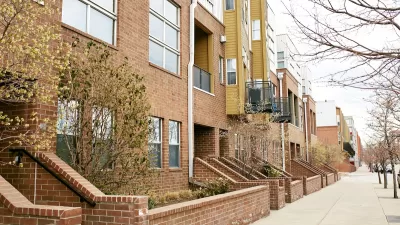A proposal in the city council could shift the burden of sidewalk repairs away from property owners, who are currently responsible for 100 percent of expenses.

After noticing the disparate states of sidewalks in different parts of her own neighborhood, Fort Worth journalist Emily Wolf examines the city’s sidewalk paving policy to find out why some sidewalks in the city are more well-maintained than others.
As it turns out, “Fort Worth has required private homeowners to maintain sidewalks since the 1960s, but stopped enforcing the penalties included in that ordinance several decades ago. What’s resulted is a patchwork of sidewalks in various states of disrepair across the city, with little recourse for owners with lower incomes or disabilities.” The issue is particularly evident in front of rental properties, Wolf notes. “Sidewalks in front of rentals, in particular, were often littered with large fractures and divots, the rentals’ owners far away from the realities of the area.”
Whether coincidentally or not, months after Wolf published a piece about the city’s inconsistent sidewalk policy and the challenges it poses for residents with disabilities, among others, “city staff presented a proposal to city council to establish a cost-sharing program similar to Dallas. Under the proposal, the city would use a portion of the fiscal year 2023 PayGo funding, totaling $2.6 million, to develop the program.” The program would have the city pay for 50 percent of the cost of repairs, “with a particular emphasis on low-income homes, seniors and disabled residents.”
FULL STORY: Walking the walk: government reporter explores the reasons for Fort Worth’s crumbling sidewalks

Alabama: Trump Terminates Settlements for Black Communities Harmed By Raw Sewage
Trump deemed the landmark civil rights agreement “illegal DEI and environmental justice policy.”

Planetizen Federal Action Tracker
A weekly monitor of how Trump’s orders and actions are impacting planners and planning in America.

The 120 Year Old Tiny Home Villages That Sheltered San Francisco’s Earthquake Refugees
More than a century ago, San Francisco mobilized to house thousands of residents displaced by the 1906 earthquake. Could their strategy offer a model for the present?

In Both Crashes and Crime, Public Transportation is Far Safer than Driving
Contrary to popular assumptions, public transportation has far lower crash and crime rates than automobile travel. For safer communities, improve and encourage transit travel.

Report: Zoning Reforms Should Complement Nashville’s Ambitious Transit Plan
Without reform, restrictive zoning codes will limit the impact of the city’s planned transit expansion and could exclude some of the residents who depend on transit the most.

Judge Orders Release of Frozen IRA, IIJA Funding
The decision is a victory for environmental groups who charged that freezing funds for critical infrastructure and disaster response programs caused “real and irreparable harm” to communities.
Urban Design for Planners 1: Software Tools
This six-course series explores essential urban design concepts using open source software and equips planners with the tools they need to participate fully in the urban design process.
Planning for Universal Design
Learn the tools for implementing Universal Design in planning regulations.
Clanton & Associates, Inc.
Jessamine County Fiscal Court
Institute for Housing and Urban Development Studies (IHS)
City of Grandview
Harvard GSD Executive Education
Toledo-Lucas County Plan Commissions
Salt Lake City
NYU Wagner Graduate School of Public Service





























